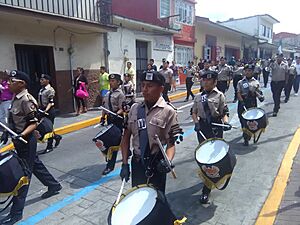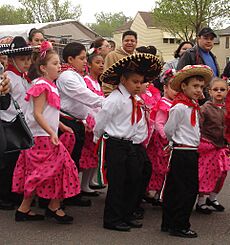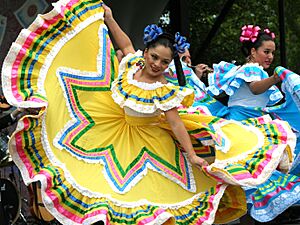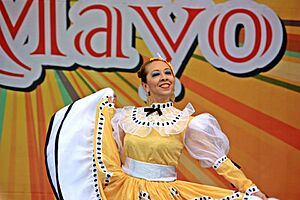Cinco de Mayo facts for kids
Template:Infobox vevent
Cinco de Mayo (which means "Fifth of May" in Spanish) is a yearly celebration held on May 5. It celebrates Mexico's victory over the Second French Empire at the Battle of Puebla in 1862. This important battle was led by General Ignacio Zaragoza.
Even though Zaragoza died later that year, and the French army eventually took Mexico City, the Battle of Puebla was a huge boost for Mexico. After the American Civil War ended in 1865, the United States helped Mexico by sending money and weapons. This support helped push the French out of Mexico. In 1866, Napoleon III announced that French troops would leave Mexico.
Cinco de Mayo is very popular in the United States, even more so than in Mexico. It has become a day to celebrate Mexican-American culture. The first celebrations in the U.S. began in Columbia, California, in 1862. The holiday became widely known in the 1980s, partly because of advertising campaigns. In Mexico, the day is mostly celebrated with military parades or battle reenactments. The city of Puebla, where the battle happened, has many festivals and reenactments.
Sometimes, people confuse Cinco de Mayo with Mexican Independence Day. Mexican Independence Day is Mexico's most important national holiday. It is celebrated on September 16 and remembers the start of Mexico's fight for freedom from Spain in 1810. Cinco de Mayo has also appeared in movies and TV shows. It has grown into a worldwide celebration of Mexican culture, food, and history.
Why We Celebrate Cinco de Mayo
Mexico's Financial Troubles
Cinco de Mayo's story begins with the Second French intervention in Mexico. This happened after two big wars in Mexico: the 1846–48 Mexican–American War and the 1858–61 Reform War. The Reform War was a civil war between two groups:
- Liberals: They believed in separating the church and state, and in religious freedom.
- Conservatives: They wanted the Catholic Church to stay closely linked with the Mexican government.
These wars left Mexico's government almost completely broke. On July 17, 1861, Mexican President Benito Juárez announced that Mexico would stop paying its foreign debts for two years.
France's Invasion and Mexico's Big Win
In response to Mexico's debt, France, Spain, and the United Kingdom met in London. They decided to send ships to Veracruz, Mexico, to demand their money back. However, France, led by Napoleon III, had other plans. Napoleon III wanted to create an empire in Mexico that would benefit France. Because of this, Britain and Spain made agreements with Mexico and left peacefully. France, however, stayed to invade.
In late 1861, a strong French fleet attacked Veracruz. They landed a large army, forcing President Juárez and his government to retreat. As the French army moved toward Mexico City, they met strong resistance near Puebla. This was at the Mexican forts of Loreto and Guadalupe. The French army had 6,500 to 8,000 soldiers. The Mexican army had only 4,000 soldiers and was not as well-equipped.
On May 5, 1862, the Mexican army bravely defeated the French army. This victory was a huge boost for the Mexican army and for all Mexican people. It helped create a strong feeling of national unity and pride.
What Happened After the Battle
The Mexican victory was important, but it didn't last long. A year later, with 30,000 troops, the French defeated the Mexican army. They captured Mexico City and put Emperor Maximilian I in charge of Mexico.
However, the French rule also didn't last long, only three years (1864 to 1867). By 1865, the American Civil War was over. The U.S. began to give more political and military help to Mexico to get rid of the French. Facing ongoing Mexican resistance and other problems, Napoleon III started to pull French troops out of Mexico in 1866.
The Mexicans then recaptured Mexico City. Emperor Maximilian I was caught and executed in Querétaro. On June 5, 1867, Benito Juárez returned to Mexico City and set up a new government.
Why the Battle Was So Important
The Battle of Puebla was very important for several reasons:
- Underdog Victory: The 4,000 Mexican soldiers were greatly outnumbered by the 8,000 well-equipped French soldiers. The French army had not been defeated in almost 50 years!
- Protecting the Americas: Some historians believe that if Mexico had not won this battle, France might have helped the Confederate States of America in the American Civil War. This could have changed the history of the United States.
- Stopping European Invasion: After this battle, some argue that no country in the Americas has been successfully invaded by a military force from Europe again.
How the Holiday Grew
Cinco de Mayo in Mexico
On May 9, 1862, President Juárez declared that the anniversary of the Battle of Puebla would be a national holiday. It was called "Battle of Puebla Day" or "Battle of Cinco de Mayo."
The celebration of Cinco de Mayo became very popular during the time of President/dictator Porfirio Díaz. He had fought in the Battle of Puebla when he was a young officer. Díaz used the Cinco de Mayo celebration to show his power. He made sure it was celebrated across Mexico and by Mexican communities in the United States. Because of this connection, celebrations in much of Mexico became less popular after Díaz was removed from power during the Mexican Revolution.

Today, Cinco de Mayo is not a national public holiday in Mexico. However, all public schools across Mexico are closed on May 5. It is an official holiday in the State of Puebla, where the battle happened. It is also a full holiday (no work) in the nearby State of Veracruz.
In Puebla, people hold historical reenactments, parades, and special meals to remember the battle. People dress up as French and Mexican soldiers to reenact the fight. The city also hosts the Festival Internacional de Puebla, with artists, musicians, and dancers. There is also the Festival Internacional del Mole, focusing on the city's famous mole poblano dish.
In Mexico City, military ceremonies are sometimes held. A street in the Historic Center of Mexico City was named Avenida Cinco de Mayo [es] after the battle in 1862.
Cinco de Mayo in the United States

The celebration of Cinco de Mayo in the United States began in California in 1863. This was in response to the Mexican resistance against French rule. In the gold mining town of Columbia, Mexican miners were so happy about the news of the victory that they fired guns, set off fireworks, sang patriotic songs, and gave speeches.
The holiday has been celebrated in California continuously since 1863. It started to become more popular in the 1940s during the rise of the Chicano Movement. It spread from California to other parts of the U.S. in the 1950s and 1960s. However, it really gained popularity in the 1980s. At that time, marketers, especially companies selling drinks, saw the chance to promote the day. It grew into a celebration of Mexican culture and heritage. This happened first in areas with many Mexican-American people, like Los Angeles and Chicago.

By 1998, there were over 120 official Cinco de Mayo celebrations in 21 different states. By 2006, this number grew to 150 or more. Los Angeles' Fiesta Broadway was once the largest Cinco de Mayo celebration in the world. It attracted crowds of 500,000 people or more in the 1990s.
On June 7, 2005, the United States Congress asked the President of the United States to encourage Americans to celebrate Cinco de Mayo. Many schools hold special events to teach students about the holiday's history. Celebrations often feature Mexican music and traditional dancing, like baile folklórico and mariachi performances. Businesses in the U.S. also use the celebration to advertise Mexican products and services, especially food and music.
Cinco de Mayo Around the World
Cinco de Mayo events also happen outside Mexico and the United States. These celebrations also highlight Mexican food, culture, and music. For example, some Canadian pubs play Mexican music and serve Mexican food. A sky-diving club near Vancouver even has a Cinco de Mayo skydiving event.
In the Cayman Islands in the Caribbean, there is an annual Cinco de Mayo air guitar competition. There is also a celebration in Montego Bay, Jamaica. The city of Brisbane, Australia, holds an annual Mexican Festival for the day. Celebrations are also held in London and New Zealand. You can also find Cinco de Mayo celebrations in Cape Town, South Africa, Lagos, Nigeria, and Paris, France. In Japan, Cinco de Mayo is celebrated in Osaka and Tokyo's Yoyogi Park as a celebration of Latin American culture.
Images for kids
Related pages
See also
 In Spanish: Cinco de Mayo para niños
In Spanish: Cinco de Mayo para niños
- List of occasions known by their dates
- Siege of Puebla (1863), fall of Puebla to the French
- Third Battle of Puebla (1867), recapture of Puebla and decisive victory for the restoration of the Republic.







